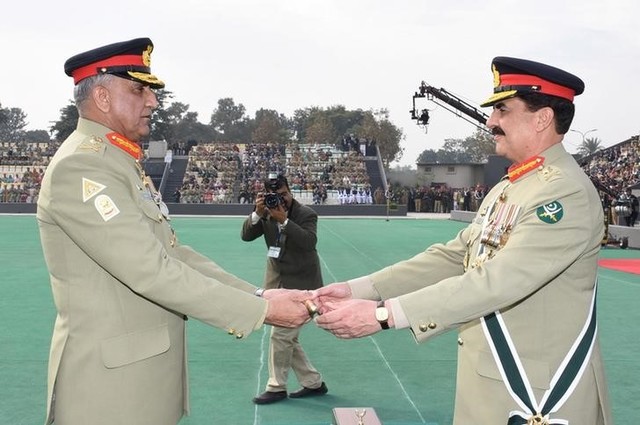
There is logic in it. If a country is internally strong and not distracted it can acquire sufficient capability to thwart external aggression and also focus on economic development more effectively. This does not imply that there has been any reduction in external threat. However, it is possible that once Pakistan is able to control India focused militant organisations then Indian accusations could largely subside.
Undoubtedly, General Sharif’s contribution in clearing the militant sanctuaries in Fata, bringing relative peace in Karachi and quelling an insurgency in Balochistan has been fairly successful. But the task is far from being over. As such, Gen Bajwa is expected to pursue this mission with added zeal, for any let-up will facilitate the TTP and other militant and sectarian organisations to make a comeback. The state will sooner rather than later also have to confront the radical organisations that are Punjab based and are known to enjoy protection of the PML-N government.

The other critical issue is how to harmonise policies of military and civilian leadership for achieving internal security and peace. With next elections in 2018 on mind, will the PML-N leadership be willing to take a firm stand against the various radical organisations operating freely in Punjab. They have to weigh the attraction of seeking votes against the hazard that is inherent in risking the country’s security and its development. The army, too, has to seriously assess whether the Kashmiri or India focused radical groups especially Jamatud Dawa are still an asset or a liability. Similarly, are we going to continue allowing Haqqani network and Taliban Shura sanctuary and expect to gain the confidence of the Afghan government? Pakistan military’s rationale for tacit acceptance of the militant groups has been that they are a force within Afghanistan and control vast areas especially those adjacent to the border. Inviting their enmity as well will add to our woes. But the flaw in this logic is that Pakistan loses moral high ground and is unable to garner international support. Apart from that it provides India and Afghanistan an alibi to engage the TTP, Baloch dissidents and other disaffected groups to work against us. It would be impossible also to win the confidence of the Afghan government if our army allows these networks to operate freely in the tribal belt and other parts of Pakistan.
Moreover, for optimum results in countering terrorism and earning international respect there has to be complete convergence and unanimity in policies between civil and military. Hopefully, with the change in military command and greater utilisation of state institutions in policy formulation this could be achieved.
Nawaz Sharif has been consistent in seeking good relations with India. With his business background he understands the value of a peaceful environment. Full benefits of CPEC will only be realisable if the two countries are able to maintain peace on the borders and also engage in trade, commerce and promote travel. Moreover, it is in China’s interest that peace prevails so the CPEC project could be executed without any hindrances. Problems created by India in Balochistan or in Gilgit-Baltistan can be a distraction.
For nearly six months the LoC has remained highly volatile with both blaming the other for initiating the firing. The question is what has it achieved apart from heightening tension and raising international concerns that the two nuclear powers could get embroiled in a conflict. Resolution of issues between these countries gets even more difficult when tensions remain high. Relations with Afghanistan are also directly or indirectly related to our relations with India. Government in Kabul has always played the Indian card to offset Pakistan’s influence in the region. Now that Islamabad or GHQ has limited influence over Afghan Taliban it further diminishes its leverage.
India despite its best efforts has failed to isolate Pakistan. On the contrary, apart from its poor showing in the immediate neighbourhood Pakistan has expanded and deepened its relations with Russia, Saudi Arabia, Turkey and Gulf states. And has taken several initiatives to open new avenues of cooperation with Central Asian states.
More importantly, both Indian and Pakistani leaderships are focused on economic development. Heightened tension and chronic fear of escalation remains a major distraction and has adverse impact on investment and resource allocation. For smooth and efficient implementation of CPEC, peace is a prerequisite. Peace is equally critical for India if it wants to maintain a high rate of growth to shed poverty. Unfortunately, lately the two chiefs of army have been trading threats and war mongering. Whereas, in Pakistan for a COAS to make statements regarding security issues is common practice but of late the Indian military leadership, too, is mimicking the same. This reflects that Indian military is gaining political clout and expanding its influence in policy formulation and decision making.
President-elect Trump has stated that he is ready and willing to play any conciliatory role that India and Pakistan would agree to. Besides, Vice President-elect Mike Pence has expressed similar views and feels that Trump can apply his business skills to help the two countries forge a better relationship. Notwithstanding that Trump is likely to strengthen relations with India for economic and strategic imperatives, New Delhi that has never accepted third party intervention is unlikely to change stance in the near future. However, what the US can do is to persuade India to engage in dialogue with Pakistan and stress the need on both countries to exercise maximum restraint on the LoC.
Continuous tension on the border and real or imaginary surgical strikes could lead to a dangerous situation for the nuclear-armed neighbours. Miscalculation between India and Pakistan during heightened tensions is very much a possibility that could trigger a serious conflict. There is one favourable aspect that there is unanimity among major powers that would like India and Pakistan to resolve their differences through dialogue.
Published in The Express Tribune, January 11th, 2017.
Like Opinion & Editorial on Facebook, follow @ETOpEd on Twitter to receive all updates on all our daily pieces.












COMMENTS (12)
Comments are moderated and generally will be posted if they are on-topic and not abusive.
For more information, please see our Comments FAQ